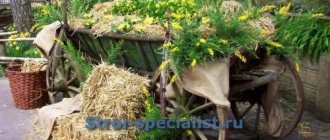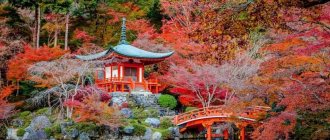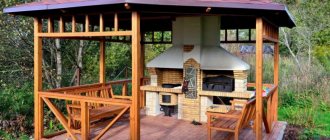0
3669
13.11.2015
- 3.1 Installation steps at the stone bowl site
The Japanese stone garden organically embodies a significant part of the original Japanese culture, which is based on an amazing symbiosis of the national religious movement of Shinto and a special, unique to the Japanese, variety of Buddhism - the philosophy of unity with nature, Zen. The embodiment of the idea that man is an inseparable part of everything that exists does not accept the concepts of “old” or “new” in relation to a rock garden, since nature itself does not possess these concepts. How to properly arrange a Japanese rock garden on your property with your own hands? Read on for the answer.
What is such a garden?
A rock garden is a small landscape on a flat surface
The Japanese rock garden is an imitation of a natural corner of nature. This composition shows a harmonious combination of natural stone and water. Various plants can be planted in a Japanese garden. At the same time, there should be an empty space around the stones, which symbolizes the freedom and vastness of the world.
In Japan, such a composition is not just an element of landscape design. Its creation is entrusted only to true masters who have undergone special training. For the Japanese, the place where the stones are located is considered sacred. Each element in such a garden has hidden symbolism. Pebbles and sand represent the water element, stones symbolize mountains and islands, and moss symbolize forested land. Vertical cobblestones are a symbol of the sky.
Principles of composition
The most important principle of composing a Japanese garden is the orientation of the composition around a single point of contemplation. It is selected in accordance with the time of day that you will spend in this garden. Most often, the point of contemplation is located on the north side, but other variations are possible.
The next principle to consider is the need to maintain contrast between filled and empty space. In addition, the basic concept of the garden should contain asymmetry. As for Japanese designers, they even take into account light and shade and the reflection of objects in water.
Another principle is the number of elements; it is worth considering that the number must be odd. Objects in a rock garden should be oriented according to a regular geometric heptagon.
Note! Landscape designers in Japan recommend maintaining a balance of horizontal and vertical lines when creating a rock garden.
Stones located horizontally should prevail over those located vertically. The fact is that there will still be more vertical lines in a Japanese stone garden due to structures, trees and fences. Horizontal orientation will dilute the verticality of other structures.
Basic Design Principles
When placing stones in a Japanese garden, you need to consider the following rules and recommendations:
- The garden should be filled only with mountain, sea or river stones. It is impossible to combine minerals from different natural zones.
- The number of stones in the garden must be odd.
- Boulders need to be combined into separate groups. Together, the stones should create a coherent composition.
- Raw stones should be used as a basis. You need to select boulders according to shape, color and texture, taking into account that they should all be of different sizes.
- The composition must be asymmetrical. When creating a Japanese garden on a site, the gardener should avoid parallel lines.
Stones in a Japanese garden should be placed in such a way that all but one of them are visible from any side of the site. According to the Japanese, only a person who has achieved enlightenment can see all the boulders.
A Japanese garden must be in harmony with the overall design of the garden plot. If such a composition does not quite fit into the existing landscape, then before starting its creation it is recommended to carry out some work. For example, you can cover the base of the house with natural stone or lay out several garden paths on the site.
Types of rockeries
Landscape designers distinguish three main styles of rockeries:
- Japanese _ Characterized by a large number of stones and blocks. And plants between them are planted as bright accents. This garden design is suitable for those who are looking for harmony and peace;
- European _ It features dynamic roller coasters similar to the natural landscape of Europe;
- English . Conifers that are distinguished by their durability, aesthetics and aristocracy are planted in them.
You can make the following types of rockeries with your own hands:
- temporary _ Set up on a flat or slightly elevated area. Seedlings are planted in it, which over time will turn into luxurious ornamental shrubs. When planting seedlings, it is important to think in advance about the size to which they will grow. The rockery is called temporary because the stones and fill are made as the bushes grow. That is, small stones are laid out first, and over time they are replaced with cobblestones (the main thing is that their sizes correspond to the dimensions of the plants);
- stable . It is suitable for those who want to decorate their yard for more than one year. Large stones are selected for its arrangement. Plants are planted here in mini-zones and separated from each other by stones. Mostly small-growing flowers and shrubs are planted here, which are easy to care for. A good choice would be: conifers, barberries, spirea;
- changeable _ This view is suitable for those who like to observe the dynamics of plant growth. For its arrangement, a small-sized area is selected, which should be divided into several separate zones (for planting plants). Every year you can plant new shrubs and flowers here.
Attention: stones placed between plants in a flower garden inhibit their growth. Thanks to this, there will be no disruption of the flower-stone composition.
Ideas for a rock garden (photo)
When creating such a structure on a personal plot, you should be inspired by natural landscapes or existing compositions. At the dacha, for example, you can build something similar to the garden found in the Buddhist temple of Ryoan-Ji. It contains 15 boulders and bushes, and the empty space is filled with gray gravel. Such a garden can be created by those gardeners who prefer discreet and minimalist compositions, and their plot is quite large.
The stones at the Ryoan-Ji Buddhist Temple are divided into groups that represent the 5 primordial elements - wood, fire, earth, metal and water.
On a small plot of land you can build something like a garden located in the Daisen-In Temple. It contains many stones, each of which is carefully selected in shape and size. An oblong boulder in this Japanese garden symbolizes a ship, and a small rounded boulder near an elevated rock resembles a turtle at the foot of a mountain. A composition compiled according to this principle will look harmonious and expressive on a summer cottage.
In the garden located at the Daisen-In Buddhist Temple, there are many different stones that are in perfect harmony with each other
Photo: sample diagrams
You can distribute stones in a Japanese garden according to a similar pattern
In a Japanese garden you can create an unusual composition called “Crane Island”
Using stones of different shapes and decorative elements, you can create a harmonious composition in your summer cottage
Rockery
Rock garden in front of the house
Large numbers of plants cannot be planted in rockeries. Decorating the garden here is achieved through the natural attractiveness of the stone. Fill the space between the garden fragments with gravel that shades the stone. If you chose limestone as the main stone, then combine it with river pebbles of different colors.
Note!
It is very important to place fertile soil under the pebbles, because it will nourish the roots of the planted plants.
In some cases, rockeries are made in the form of architectural forms. Well, for example, they can be made in the form of steps made of large flat stone. It will be framed by creeping plants, which are more typical for mountainous regions. In cases where the area for rock gardens has a natural slope, it is better to make it terraced. This way you can combine natural objects, namely stones, plants and shrubs.
Selection of stones
When arranging an eastern rock garden, it is customary to use granite, tuff, basalt and other stones of volcanic origin.
To create a traditional Japanese garden at the dacha, minerals of volcanic origin (granite, basalt) are suitable. One of the most important rules to consider when choosing boulders is the shape of the stones. Experts distinguish 5 main types of decorative cobblestones:
- flat;
- curved;
- recumbent;
- vertical;
- horizontal (statues).
It is desirable that the stones used to create single compositions be of ideal shape. It is recommended to group specimens with any defects with other cobblestones that will cover up their flaws.
When choosing stones, the gardener will also need to take into account the following nuances:
- Single color scheme. There are no strict restrictions on the color of the stones, but it is not advisable to place bright boulders. It is necessary that all cobblestones be kept in a certain color scheme, since the Japanese garden is characterized by monochrome. In such a composition, only pebbles, symbolizing water, can be of a lighter shade.
- Natural look. It is worth giving preference to cobblestones with traces of the influence of nature (moss, leaching).
- Texture. You should choose specimens that will harmonize well with each other.
- Hardness and structure. These qualities determine the durability of the composition.
Large cobblestones represent the masculine principle among the Japanese, and small ones represent the feminine principle.
If you were unable to find suitable boulders on your own, you can purchase them in specialized stores. Some flower growers prefer to use the services of masters who make artificial cobblestones. Externally, such specimens do not differ from natural stones, but are quite expensive. They undergo additional processing, during which craftsmen create chips and cracks on their surface. Unlike such specimens, natural stones do not need to be processed before planting.
Useful tips
There are many tips on how to make a rock garden at your dacha with your own hands, in accordance with all Eastern traditions. But some recommendations are still worth mentioning:
- boulders that are similar in size, shape, shade, or equal in height should not be placed close to each other;
- it is better to make a composition from stones of the same origin, for example, those found in the mountains, near a river or on the seashore;
- the color palette should be similar, or even better, monotonous; the cobblestones should not have a contrasting color.
Suitable plants
Vegetation will help revive the composition of stones. But it should be remembered that plants in a Japanese garden are only decoration and a frame for stones, so there should be few of them. The following types are suitable for the Japanese garden:
- shrubs (barberry, juniper, cotoneaster);
- ground cover (iberis, saxifrage);
- low-growing trees (pine, rowan, fir);
- herbaceous (edelweiss, crocus, geranium).
One of the most popular plants for Japanese gardens is moss, which fits perfectly into almost any composition.
There shouldn't be too many plants in a Japanese garden.
Plants can be placed singly or in groups. It is recommended to plant the selected trees and shrubs before filling the area with gravel and sand. The plant can be placed in a Japanese garden and directly in pots. Large pots made of ceramics can become part of the composition. Unsightly small containers can be disguised under gravel.
Styles
The type of composition of the stone garden plays an important role. The attractiveness of the territory and the design of flowers depend on it. Below are the most popular rockery design styles:
- Japanese. Japanese rockeries are the embodiment of sophistication, moderation, and restraint. They are characterized by the absence of bright colors, an abundance of stones and the presence of wavy lines directly on the embankment. Decorative conifers will fit perfectly here.
- English. The style can be recognized by evergreen coniferous shrubs, cereals, ornamental varieties of wormwood, and a variety of flowering and deciduous plants.
- European. The implementation of such an idea requires a serious approach to the choice of vegetation. It is better to choose plants that are easy to care for. The shape and color of the leaves can be any.
- German. Such flower beds are strict and practical. The stones are not just laid out in a pile. Benches are made from them.
- Italian. Italian rockery design implies aesthetics and elegance, as well as the presence of smooth lines, pastel colors and round complementary accessories. It is appropriate to add metal furniture or a stone statue to the composition.
Additional decor
An important element of the composition is additional decor, which is used as:
- patterns in sand and gravel;
- tsukubai;
- small bridges;
- fences;
- lanterns
Patterns on sand or gravel will perfectly complement the composition
Patterns in the sand should be given special attention. For the Japanese, each of them has a specific meaning. Their straight lines symbolize the surface of the water, and the curves symbolize seething streams. The circles around the boulders represent sea waves. Such patterns can be created using a rake with special attachments, the teeth of which have different widths and shapes.
Tsukubai gives a static Japanese garden some dynamics
Tsukubai is a small stone bowl filled with water. The liquid enters it through pipes located underground. Tsukubai enlivens the composition without disturbing the overall atmosphere. In Japanese culture, bridges are the connecting link between different periods of life. Small bridges made of horizontal solid stones will fit well into the composition.
A hedge will help recreate the atmosphere of privacy in a rock garden
Fences can be installed on one or both sides. It is recommended to make the fence from an opaque material, for example, concrete or bamboo.
Compact lanterns fit perfectly into the design of a rocky garden
In a rocky garden, you can install small stone or wooden lanterns. They will not only complement the composition, but will also illuminate the area in the evening and at night.
We use materials provided by the sea
Crafts made from sea stones are especially popular. A holiday at sea makes it possible to deliver a huge amount of ornamental material. A little inspiration, desire, creative touch, the presence of plasticine, polymer clay, glue, colored paints will help decorate any room and open space.
Macrame
The work is not difficult, it requires regularity and perseverance. Available for both children and adults. The following actions must be taken:
- take dense threads of different shades (preferably bright) and braid them;
- several braids are intertwined;
- one large or several small pebbles are inserted into the center of the weaving;
- the braids are connected by knots, braiding stones;
- You can decorate macrame with glued rhinestones of a suitable color.
Sea pebbles differ from each other in their bizarre shape and shade. If there is a natural hole, you can simply thread a string and hang the jewelry around your neck. To make the stone more attractive, it can be varnished or painted in a bright color.
Photo
Finding a large flat stone on the sea coast is not a problem. Using a drill, several holes are made in it, and a thick silk thread is threaded. The bracelet is ready.
Small flat stones of different shades are suitable for making beads. A thin cord is threaded through the holes made. To add strength, you can separate all the stones into knots. Don't forget to attach a lock.
A simple but quite unique craft. How to make a refrigerator magnet with your own hands? It is enough to find a small flat pebble and draw an animal (chicken, dog, kitten) on it. Attach a small magnet to the back side.
Decoration of glass bottles
We use sea pebbles and shells. We use one of two options:
| Option one | Take a bottle and decorate it with small pebbles, creating simple designs or patterns. Glue should not be used. You need to cover the glass with a thin layer of plasticine, onto which you attach the ornamental material. |
| Option two | The transparent container is washed, dried, and small pebbles, shells, and pieces of glass are placed inside. The bottle is closed with a cap. |
Step-by-step instructions for creating a rock garden with your own hands
First you need to prepare the tools that will be needed when creating a rock garden. The florist will need:
- geotextile or agrofibre;
- gravel or sand;
- wooden rakes;
- bayonet shovel;
- selected rocks and plants;
- decorative elements (if any).
It is necessary to arrange a rocky garden on the site in the following sequence:
- Mark the contours of the future composition in the area allocated for the rocky garden. This can be done using a rope.
- Remove the top layer of soil with a shovel.
- Remove weeds from the area and treat the soil with herbicides if necessary.
- Prepare the base for a rocky garden by covering the area with covering material and filling it with sand or gravel.
- Dig holes for the stones. They should be slightly larger in size than the base of the selected cobblestones.
- Pour gravel into the bottom of the dug holes.
- Place the cobblestones in the prepared places and fill the space around them with a mixture of soil and gravel. Using the same principle, you need to lay out small stones.
- Plant shrubs or any other tall plants near large boulders, and dwarf specimens near small stones.
- Add decorative elements and draw patterns in the sand with a rake.
Video: master class from a landscape designer
Video description
The following video will show you how to make a pond on a hilly area:
Starting from it, it is easy to alternate planes and plant masses, combine smooth shore lines and steep cliffs of hills and mountains, plant small ones next to large plants, create a balance of contrasts in everything. Then everything will work out quite naturally.
Tea garden
When creating it, designers pursue one goal: they create an atmosphere of complete peace in which you can admire nature and enjoy its tranquility. A corner of mountainous terrain is formed in a small area. It was there that sages and philosophers usually settled in Japan. In the depths of such a garden there should be a gazebo for the tea ceremony. It is called “Chashitsu” in the Land of the Rising Sun. Its appearance should resemble the dwelling of the sages. They preferred to exist in an atmosphere of strict asceticism. It is believed that it is she who can open up a person’s ability to tune in to contemplating the beauty of nature.
Tea house in the depths of a mountainous area Source tureks.ru
Care instructions
The advantage of a Japanese garden is that it is quite easy to care for. The florist will need to perform only a few of the following procedures:
- Clear gravel of debris. It is recommended to carry out the procedure using a stiff brush. However, such a tool is only suitable if the gravel has not yet been compacted, otherwise the gardener will have to remove the debris manually.
- Remove weeds. Weeds should be pulled out by the roots.
- Take care of plants. Caring for plantings in a rocky garden comes down to abundant, infrequent watering. There is no need to apply fertilizers.
Common mistakes when arranging rockeries
Common mistakes among gardeners when arranging stone gardens in the yard are:
- improper arrangement of a rocky flowerbed;
- selection of stones of different styles and origins;
- incorrect placement of stones;
- a large number of plants planted in the flowerbed;
- wrong location of the flower bed;
- a few years after creating a flower garden, the stones are completely covered by plants;
- the soil subsides and boulders shift;
- improper care of plants.











